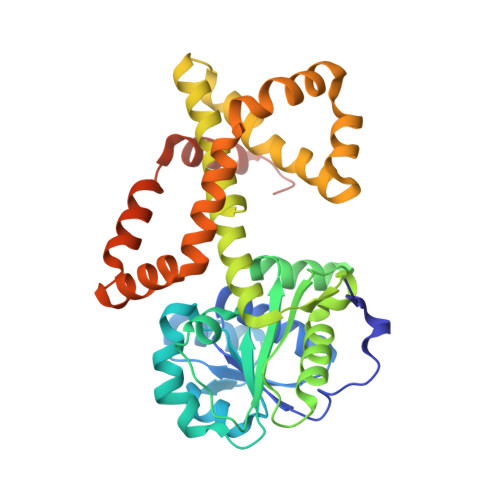Crystal Structures of Staphylococcus aureus Ketol-Acid Reductoisomerase in Complex with Two Transition State Analogues that Have Biocidal Activity.
Patel, K.M., Teran, D., Zheng, S., Kandale, A., Garcia, M., Lv, Y., Schembri, M.A., McGeary, R.P., Schenk, G., Guddat, L.W.(2017) Chemistry 23: 18289-18295
- PubMed: 28975665
- DOI: https://doi.org/10.1002/chem.201704481
- Primary Citation of Related Structures:
5W3K, 6AQJ - PubMed Abstract:
Ketol-acid reductoisomerase (KARI) is an NAD(P)H and Mg 2+ -dependent enzyme of the branched-chain amino acid (BCAA) biosynthesis pathway. Here, the first crystal structures of Staphylococcus aureus (Sa) KARI in complex with two transition state analogues, cyclopropane-1,1-dicarboxylate (CPD) and N-isopropyloxalyl hydroxamate (IpOHA) are reported. These compounds bind competitively and in multi-dentate manner to KARI with K i values of 2.73?¦̀m and 7.9?nm, respectively; however, IpOHA binds slowly to the enzyme. Interestingly, intact IpOHA is present in only ¡Ö25?% of binding sites, whereas its deoxygenated form is present in the remaining sites. This deoxy form of IpOHA binds rapidly to Sa KARI, but with much weaker affinity (K i =21?¦̀m). Thus, our data pinpoint the origin of the slow binding mechanism of IpOHA. Furthermore, we propose that CPD mimics the early stage of the catalytic reaction (preceding the reduction step), whereas IpOHA mimics the late stage (after the reduction took place). These structural insights will guide strategies to design potent and rapidly binding derivatives of these compounds for the development of novel biocides.
Organizational Affiliation:
School of Chemistry and Molecular Biosciences, The University of Queensland, Brisbane, 4072, Australia.




















